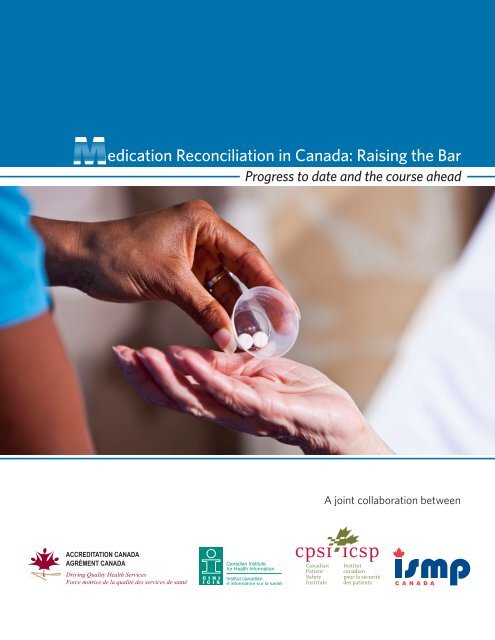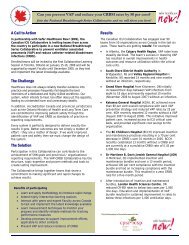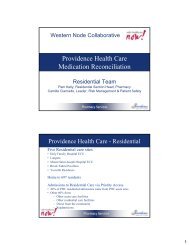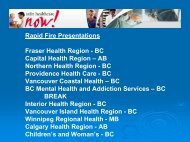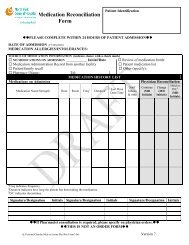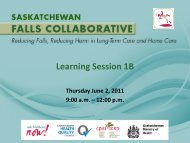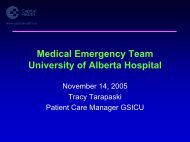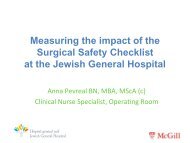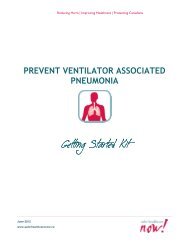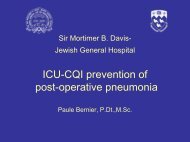Medication Reconciliation in Canada: Raising the Bar (2012) - CIHI
Medication Reconciliation in Canada: Raising the Bar (2012) - CIHI
Medication Reconciliation in Canada: Raising the Bar (2012) - CIHI
- No tags were found...
You also want an ePaper? Increase the reach of your titles
YUMPU automatically turns print PDFs into web optimized ePapers that Google loves.
<strong>Medication</strong> <strong>Reconciliation</strong> <strong>in</strong> <strong>Canada</strong>: Rais<strong>in</strong>g The <strong>Bar</strong>Progress to date and <strong>the</strong> course aheadAccreditation <strong>Canada</strong>, <strong>the</strong> Canadian Institute for Health Information, <strong>the</strong> Canadian PatientSafety Institute, and <strong>the</strong> Institute for Safe <strong>Medication</strong> Practices <strong>Canada</strong> reta<strong>in</strong> all <strong>in</strong>tellectualproperty rights for <strong>the</strong> <strong>in</strong>formation presented here, unless o<strong>the</strong>rwise specified.© <strong>2012</strong> Accreditation <strong>Canada</strong>, <strong>the</strong> Canadian Institute for Health Information, <strong>the</strong> CanadianPatient Safety Institute, <strong>the</strong> Institute for Safe <strong>Medication</strong> Practices <strong>Canada</strong>How to cite this document:Accreditation <strong>Canada</strong>, <strong>the</strong> Canadian Institute for Health Information, <strong>the</strong> Canadian PatientSafety Institute, and <strong>the</strong> Institute for Safe <strong>Medication</strong> Practices <strong>Canada</strong>. (<strong>2012</strong>). <strong>Medication</strong><strong>Reconciliation</strong> <strong>in</strong> <strong>Canada</strong>: Rais<strong>in</strong>g The <strong>Bar</strong> – Progress to date and <strong>the</strong> course ahead.Ottawa, ON: Accreditation <strong>Canada</strong>.Also issued <strong>in</strong> French under <strong>the</strong> title:Bilan comparatif des médicaments au <strong>Canada</strong> : hausser la barreProgrès à ce jour et chem<strong>in</strong> à parcourir
Table of Contents<strong>Medication</strong> <strong>Reconciliation</strong> <strong>in</strong> <strong>Canada</strong>: Rais<strong>in</strong>g <strong>the</strong> <strong>Bar</strong> . . . . . . . . . . . . . . . . . . . . . . . . . . . . . . .5<strong>Medication</strong> <strong>Reconciliation</strong>: Reduc<strong>in</strong>g risks for patients and <strong>the</strong> health system . . . . . . . . . . .6Hospital Readmissions . . . . . . . . . . . . . . . . . . . . . . . . . . . . . . . . . . . . . . . . . . . . . . . . . . . . . .6Ambulatory Care Sensitive Conditions . . . . . . . . . . . . . . . . . . . . . . . . . . . . . . . . . . . . . . . . . .7<strong>Medication</strong> Use <strong>in</strong> Seniors . . . . . . . . . . . . . . . . . . . . . . . . . . . . . . . . . . . . . . . . . . . . . . . . . . . .8<strong>Medication</strong> <strong>Reconciliation</strong> <strong>in</strong> <strong>Canada</strong>: Considerable progress has been achieved . . . . . . . .9<strong>Medication</strong> <strong>Reconciliation</strong>: A Priority for Accreditation <strong>Canada</strong> . . . . . . . . . . . . . . . . . . . . . . . .9A Snapshot of <strong>Medication</strong> <strong>Reconciliation</strong> <strong>in</strong> <strong>Canada</strong> . . . . . . . . . . . . . . . . . . . . . . . . . . . . . . .10Renew<strong>in</strong>g <strong>the</strong> Focus on <strong>Medication</strong> <strong>Reconciliation</strong> Over <strong>the</strong> Last Two Years:Secur<strong>in</strong>g support and shar<strong>in</strong>g resources . . . . . . . . . . . . . . . . . . . . . . . . . . . . . . . . . . . . . . . . . 14Consensus Statement . . . . . . . . . . . . . . . . . . . . . . . . . . . . . . . . . . . . . . . . . . . . . . . . . . . . . . 14MedRec Check-Up Map and Lead<strong>in</strong>g Practices . . . . . . . . . . . . . . . . . . . . . . . . . . . . . . . . . . 15MyMedRec . . . . . . . . . . . . . . . . . . . . . . . . . . . . . . . . . . . . . . . . . . . . . . . . . . . . . . . . . . . . . . 16The Future of <strong>Medication</strong> <strong>Reconciliation</strong> <strong>in</strong> <strong>Canada</strong>: Where to from here? . . . . . . . . . . . . . . 17Look<strong>in</strong>g Ahead: <strong>Medication</strong> <strong>Reconciliation</strong> for All . . . . . . . . . . . . . . . . . . . . . . . . . . . . . . . . .18Appendices . . . . . . . . . . . . . . . . . . . . . . . . . . . . . . . . . . . . . . . . . . . . . . . . . . . . . . . . . . . . . . . . . 19Figure A.1 – A profile of unplanned hospital readmissions <strong>in</strong> <strong>Canada</strong>: Conditionsrepresent<strong>in</strong>g <strong>the</strong> largest number of readmissions and <strong>the</strong>ir reasons forreturn, for medical patients . . . . . . . . . . . . . . . . . . . . . . . . . . . . . . . . . . . . . . . . 19Figure A.2 – A profile of ambulatory care sensitive conditions: Age-standardizedrate of ambulatory care sensitive conditions, 2010-2011,by Health Region, <strong>Canada</strong> . . . . . . . . . . . . . . . . . . . . . . . . . . . . . . . . . . . . . . . . 20Figure A.3 – A profile of medication use <strong>in</strong> Canadian seniors: Age-sex standardizedrate of chronic Beers drug use among seniors on public drug programs,selected prov<strong>in</strong>ces, 2009 . . . . . . . . . . . . . . . . . . . . . . . . . . . . . . . . . . . . . . . . . 22Figure A.4 – National compliance rates with <strong>the</strong> Accreditation <strong>Canada</strong> medicationreconciliation ROPs . . . . . . . . . . . . . . . . . . . . . . . . . . . . . . . . . . . . . . . . . . . . . 23References . . . . . . . . . . . . . . . . . . . . . . . . . . . . . . . . . . . . . . . . . . . . . . . . . . . . . . . . . . . . . . . . . .24<strong>Medication</strong> <strong>Reconciliation</strong> <strong>in</strong> <strong>Canada</strong>: Rais<strong>in</strong>g <strong>the</strong> <strong>Bar</strong>3
<strong>Medication</strong> <strong>Reconciliation</strong> <strong>in</strong> <strong>Canada</strong>:Rais<strong>in</strong>g <strong>the</strong> <strong>Bar</strong>Communicat<strong>in</strong>g effectively about medications is a critical component of deliver<strong>in</strong>g safe care.Without it, patients are at risk. By identify<strong>in</strong>g and resolv<strong>in</strong>g medication discrepancies, <strong>the</strong> likelihoodof adverse events occurr<strong>in</strong>g with<strong>in</strong> health care organizations across <strong>the</strong> cont<strong>in</strong>uum of care will bereduced.Us<strong>in</strong>g medication reconciliation, health care providers follow a formal process to work toge<strong>the</strong>r withpatients, families and care providers to ensure accurate and comprehensive medication 1 <strong>in</strong>formationis communicated consistently across transitions of care. <strong>Medication</strong> reconciliation is a systematicand comprehensive review of all <strong>the</strong> medications a patient is tak<strong>in</strong>g to ensure that medications be<strong>in</strong>gadded, changed or discont<strong>in</strong>ued are carefully assessed and documented. Endorsed by patientsafety organizations around <strong>the</strong> world, medication reconciliation is <strong>in</strong>tended to ensure accuratecommunication at care transition po<strong>in</strong>ts, for example, when patients enter a hospital, transition toano<strong>the</strong>r service or provider, or are discharged home.A high proportion of adverse events are drug-related (Samoy et al., 2006; Baker et al., 2004).<strong>Medication</strong> reconciliation can help br<strong>in</strong>g <strong>the</strong>se numbers down:• The total cost of preventable, drug-related hospitalizations is about $2.6 billion per year(Hohl et al., 2011).• 20% of patients discharged from acute care facilities experience an adverse event, and ofthose, 66% are drug-related (Forster et al., 2003).How are organizations across all sectors of <strong>the</strong> Canadian health care system progress<strong>in</strong>g withmedication reconciliation? Which groups of <strong>the</strong> Canadian population are most at risk? What aspectsof medication reconciliation do organizations perform well and what aspects present challenges?What resources are available to help organizations implement medication reconciliation? In thisreport, four national health care organizations – Accreditation <strong>Canada</strong>, <strong>the</strong> Canadian Institute forHealth Information, <strong>the</strong> Canadian Patient Safety Institute, and <strong>the</strong> Institute for Safe <strong>Medication</strong>Practices <strong>Canada</strong> – share <strong>in</strong>formation about medication reconciliation <strong>in</strong> <strong>Canada</strong>, thus pa<strong>in</strong>t<strong>in</strong>g acomprehensive picture of <strong>the</strong> situation.1<strong>Medication</strong>s <strong>in</strong>clude prescription medications, herbal remedies (e.g., St. John’s Wort), and over-<strong>the</strong>-counter medications.<strong>Medication</strong> <strong>Reconciliation</strong> <strong>in</strong> <strong>Canada</strong>: Rais<strong>in</strong>g <strong>the</strong> <strong>Bar</strong>5
<strong>Medication</strong> <strong>Reconciliation</strong>:Reduc<strong>in</strong>g risks for patients and <strong>the</strong> health system<strong>Medication</strong> reconciliation may help to prevent unplanned hospital readmissions and hospitalizationsfor ambulatory care sensitive conditions.Hospital ReadmissionsUnplanned hospital readmissions to acute care are common, costly, and potentially avoidable.Unplanned hospital readmissions represent a burden to patients and <strong>the</strong>ir family members as wellas to <strong>the</strong> health care system. Better communication about medication use at <strong>the</strong> time of dischargefrom hospital can reduce unplanned hospital readmissions and return emergency department visits,both of which are costly for <strong>the</strong> health system and disruptive for patients. <strong>Medication</strong> reconciliationcan reduce some cases of unplanned readmission by prevent<strong>in</strong>g those caused by drug <strong>in</strong>teractionsand side effects. Figure 1 highlights <strong>the</strong> populations affected and <strong>the</strong> costs associated with hospitalreadmissions.Figure 1 – A profile of unplanned hospital readmissions <strong>in</strong> <strong>Canada</strong>• More than 180,000 Canadians had an unplanned readmission to acute care with<strong>in</strong> 30 days ofdischarge <strong>in</strong> 2010, cost<strong>in</strong>g an estimated $1.8 billion and account<strong>in</strong>g for 11% of all acute hospitalcosts.• The overall rate of readmission to <strong>in</strong>patient acute care <strong>in</strong> 30 days was 8.5%; this rate was highestfor medical patients (13%). The rate of return to <strong>the</strong> emergency department with<strong>in</strong> 7 days was11% for medical patients <strong>in</strong> jurisdictions where it could be measured.• Chronic conditions and <strong>the</strong> number of o<strong>the</strong>r pre-exist<strong>in</strong>g conditions were important risk factors forreadmission. Among medical patients, those with chronic obstructive pulmonary disease (COPD)had <strong>the</strong> highest number of readmissions, followed by patients with heart failure. These patientsoften require multiple medications to manage <strong>the</strong>ir conditions after discharge.Source: Canadian Institute for Health Information. All-Cause Readmission to Acute Care and Return to <strong>the</strong>Emergency Department. (Ottawa, ON.: <strong>CIHI</strong>, <strong>2012</strong>). Fur<strong>the</strong>r <strong>in</strong>formation can be found <strong>in</strong> <strong>the</strong> appendix, Figure A.1. Thefull report is available at www.cihi.ca.6 <strong>Medication</strong> <strong>Reconciliation</strong> <strong>in</strong> <strong>Canada</strong>: Rais<strong>in</strong>g <strong>the</strong> <strong>Bar</strong>
Ambulatory Care Sensitive ConditionsBetter management of medications may lead to fewer hospitalizations for ambulatory care sensitiveconditions. Ambulatory care sensitive conditions <strong>in</strong>clude asthma, chronic obstructive pulmonarydisease, diabetes, high blood pressure and heart diseases. These conditions cause considerableillness, hospitalizations and death among Canadians, affect<strong>in</strong>g an estimated 6.8 million Canadiansaged 20 to 74, and result<strong>in</strong>g <strong>in</strong> about 13,000 deaths annually. Many of <strong>the</strong> complications andresult<strong>in</strong>g hospitalizations associated with <strong>the</strong>se conditions can be avoided or delayed withappropriate community care, <strong>in</strong>clud<strong>in</strong>g regular monitor<strong>in</strong>g, healthy lifestyles, drug <strong>the</strong>rapies, andregular visits with primary care providers.These conditions often require medication as treatment and many patients with <strong>the</strong>se chronicconditions take several types of drugs on a regular basis. However, as shown <strong>in</strong> Figure 2, patientsreport that <strong>the</strong>y do not receive enough <strong>in</strong>formation from <strong>the</strong>ir primary health care provider onpotential side effects and appropriate use of <strong>the</strong>ir medications. <strong>Medication</strong> reconciliation can play animportant role <strong>in</strong> properly manag<strong>in</strong>g <strong>the</strong>se conditions <strong>in</strong> <strong>the</strong> community, result<strong>in</strong>g <strong>in</strong> better control of<strong>the</strong> condition and fewer patients be<strong>in</strong>g admitted to acute care for treatment.Figure 2 – A profile of ambulatory care sensitive conditions <strong>in</strong> <strong>Canada</strong>• In 2010-2011, <strong>the</strong> age-standardized rate of ambulatory care sensitive conditions <strong>in</strong> <strong>Canada</strong> was299 per 100,000. This rate varied substantially between jurisdictions.• Over 40% of adults with at least one ambulatory care sensitive condition <strong>in</strong> 2008 reported notreceiv<strong>in</strong>g appropriate management of <strong>the</strong>ir medications, and 58% reviewed and discussedprescription medications with <strong>the</strong>ir family physician.Sources: Canadian Institute for Health Information. Health Indicators <strong>2012</strong>. (Ottawa, ON.: <strong>CIHI</strong>, <strong>2012</strong>) and Disparities<strong>in</strong> Primary Health Care Experiences Among Canadians With Ambulatory Care Sensitive Conditions (Ottawa, ON.:<strong>CIHI</strong>, <strong>2012</strong>). Fur<strong>the</strong>r <strong>in</strong>formation can be found <strong>in</strong> <strong>the</strong> appendix, Figure A.2. The full reports are available atwww.cihi.ca.<strong>Medication</strong> <strong>Reconciliation</strong> <strong>in</strong> <strong>Canada</strong>: Rais<strong>in</strong>g <strong>the</strong> <strong>Bar</strong>7
<strong>Medication</strong> Use <strong>in</strong> SeniorsIn 2011, <strong>the</strong> first members of <strong>the</strong> baby boom generation turned 65. As seniors age, many developa progressively complex mix of health conditions that require a grow<strong>in</strong>g number of medications toprevent <strong>the</strong> development of more serious illness. Seniors take more medications than any o<strong>the</strong>r agegroup, and are <strong>the</strong>refore more at risk of potential drug <strong>in</strong>teractions or adverse events. In fact, seniors<strong>in</strong> <strong>Canada</strong> take four times more over-<strong>the</strong>-counter medications than any o<strong>the</strong>r age group. With manyseniors tak<strong>in</strong>g multiple drugs on a daily basis, effective medication management is critical. Figure 3profiles medication use by seniors.Figure 3 – A profile of medication use <strong>in</strong> Canadian seniors• In 2009, 63% of seniors claimed five or more drugs from different drug classes. 23% had claimsfor 10 or more.• More than half (52%) of seniors on public drug programs <strong>in</strong> six report<strong>in</strong>g prov<strong>in</strong>ces were us<strong>in</strong>gdrugs on a regular basis to treat two or more chronic conditions, while a quarter (25%) werechronically us<strong>in</strong>g drugs to treat 3 or more conditions. Among seniors who were chronic drugusers, 65% were tak<strong>in</strong>g a drug to treat high blood pressure or heart failure.• The most common drug classes used by seniors <strong>in</strong> 2010-2011 were HMG CoA-reductase<strong>in</strong>hibitors (most commonly used to treat high cholesterol levels), used by 47% of seniors, andAce <strong>in</strong>hibitors (most often used to treat heart failure and high blood pressure), used by 30% ofseniors.• The Beers list is an <strong>in</strong>ternationally recognized list of drugs identified as potentially <strong>in</strong>appropriatebecause <strong>the</strong> drugs are ei<strong>the</strong>r <strong>in</strong>effective or pose an unnecessarily high risk for older persons anda safer alternative is available. When look<strong>in</strong>g at drug use by seniors on public drug programs,more than 1 <strong>in</strong> 10 seniors was tak<strong>in</strong>g a drug from <strong>the</strong> Beers list on a regular basis <strong>in</strong> 2009 (afteradjust<strong>in</strong>g for age and sex). In 2009, public drug program spend<strong>in</strong>g on Beers drugs used on achronic basis was roughly $15 million, account<strong>in</strong>g for 1.4% of total program spend<strong>in</strong>g on seniors.Fur<strong>the</strong>r <strong>in</strong>formation can be found <strong>in</strong> <strong>the</strong> appendix, Figure A.3.Sources: Canadian Institute for Health Information. Health Care <strong>in</strong> <strong>Canada</strong> 2011: A Focus on Seniors and Ag<strong>in</strong>g.(Ottawa, ON.: <strong>CIHI</strong>, 2011) and Canadian Institute for Health Information. A Snapshot of Health Care <strong>in</strong> <strong>Canada</strong> asDemonstrated by Top 10 Lists. (Ottawa, ON.: <strong>CIHI</strong>, 2011). The full reports are available at www.cihi.ca.In summary, <strong>the</strong> benefits of medication reconciliation are well-established, <strong>in</strong>clud<strong>in</strong>g reduced risk ofmedication errors, improved cl<strong>in</strong>ical outcomes, and <strong>in</strong>creased system efficiency. System efficiencyis achieved <strong>in</strong> part through cost avoidance, by reduc<strong>in</strong>g unnecessary admissions, and a reduction <strong>in</strong>medication-related adverse events.8 <strong>Medication</strong> <strong>Reconciliation</strong> <strong>in</strong> <strong>Canada</strong>: Rais<strong>in</strong>g <strong>the</strong> <strong>Bar</strong>
This assessment and validation of compliance contributes to improv<strong>in</strong>g quality and safety, mitigatesrisk, contributes to enabl<strong>in</strong>g <strong>the</strong> organization and/or jurisdiction to achieve its priorities, andpromotes organizational effectiveness through identification of areas of strength and areas forimprovement.First <strong>in</strong>troduced <strong>in</strong>to <strong>the</strong> accreditation program <strong>in</strong> 2005, Required Organizational Practices (ROPs)are evidence-based practices that mitigate risk and contribute to improv<strong>in</strong>g <strong>the</strong> quality and safetyof health services. In order to ensure <strong>the</strong>ir cont<strong>in</strong>u<strong>in</strong>g relevance, all ROPs are developed and<strong>in</strong>tegrated <strong>in</strong>to <strong>the</strong> program with <strong>in</strong>put from health care experts <strong>in</strong>clud<strong>in</strong>g practitioners, researchers,policy-makers, m<strong>in</strong>istries of health personnel, academics, and health services providers at <strong>the</strong>prov<strong>in</strong>cial, territorial, and national levels. Exist<strong>in</strong>g <strong>in</strong>itiatives and priorities with<strong>in</strong> each jurisdictionare important considerations <strong>in</strong> <strong>the</strong> development process. Each ROP is supported by research,<strong>in</strong>clud<strong>in</strong>g evidence that <strong>the</strong> safety practice contributes to <strong>the</strong> reduction of health care costs.<strong>Medication</strong> reconciliation was <strong>in</strong>troduced <strong>in</strong>to <strong>the</strong> Accreditation <strong>Canada</strong> program <strong>in</strong> 2005 forassessment <strong>in</strong> 2006 based on <strong>the</strong> recommendations of <strong>the</strong> Accreditation <strong>Canada</strong> Patient SafetyAdvisory Committee. The emerg<strong>in</strong>g evidence demonstrated that medication reconciliation reducedmedication errors. Two ROPs are <strong>in</strong>cluded <strong>in</strong> many of <strong>the</strong> Accreditation <strong>Canada</strong> standards. Theseare: <strong>Medication</strong> <strong>Reconciliation</strong> at Admission and <strong>Medication</strong> <strong>Reconciliation</strong> at Transfer or Discharge.These service-level ROPs cover <strong>the</strong> detailed steps of <strong>the</strong> medication reconciliation process, such ascomplet<strong>in</strong>g a Best Possible <strong>Medication</strong> History and communicat<strong>in</strong>g up-to-date medication lists to <strong>the</strong>next care provider.Recogniz<strong>in</strong>g <strong>the</strong> resources, <strong>in</strong>frastructure, and process change challenges faced by organizationsacross <strong>Canada</strong> <strong>in</strong> <strong>the</strong> successful implementation of medication reconciliation, <strong>the</strong> Qmentumaccreditation program requirements for medication reconciliation were scaled back <strong>in</strong> 2008. Thecurrent approach is detailed <strong>in</strong> <strong>the</strong> Accreditation <strong>Canada</strong> Leadership Standards as <strong>the</strong> <strong>Medication</strong><strong>Reconciliation</strong> as an Organizational Priority ROP, which requires <strong>the</strong> follow<strong>in</strong>g:• <strong>Medication</strong> reconciliation is implemented <strong>in</strong> one client service area at admission and one clientservice area at transfer or discharge.• There is a documented plan to implement medication reconciliation throughout <strong>the</strong> organization,which <strong>in</strong>cludes locations and timel<strong>in</strong>es.In order to facilitate implementation, <strong>the</strong> Accreditation <strong>Canada</strong> medication reconciliation ROPswere re-exam<strong>in</strong>ed <strong>in</strong> close partnership with ISMP <strong>Canada</strong>, CPSI, and stakeholders from across<strong>Canada</strong>. As a result, <strong>the</strong> ROPs were customized with specific guidel<strong>in</strong>es and tests for compliance.In 2010-2011, <strong>the</strong> <strong>Medication</strong> <strong>Reconciliation</strong> at Admission ROP was adjusted to <strong>in</strong>corporate <strong>the</strong>unique requirements of ambulatory/outpatient services, home/community services, and emergencydepartments. In 2011-<strong>2012</strong>, <strong>the</strong> <strong>Medication</strong> <strong>Reconciliation</strong> at Transfer or Discharge ROP wasenhanced to clarify <strong>the</strong> important process steps for acute care, long-term care, ambulatory/outpatient services, and home/community services.A Snapshot of <strong>Medication</strong> <strong>Reconciliation</strong> <strong>in</strong> <strong>Canada</strong>The Accreditation <strong>Canada</strong> ROPsS<strong>in</strong>ce <strong>the</strong> Qmentum accreditation program was <strong>in</strong>troduced <strong>in</strong> 2008, <strong>the</strong>re has been a gradualimprovement <strong>in</strong> organizational performance on medication reconciliation ROPs across <strong>the</strong>cont<strong>in</strong>uum of care. Of <strong>the</strong> current 37 Qmentum program ROPs, <strong>the</strong> medication reconciliationROPs had <strong>the</strong> greatest improvement <strong>in</strong> <strong>the</strong> past year. As shown <strong>in</strong> Figure 4, Canadian health care10 <strong>Medication</strong> <strong>Reconciliation</strong> <strong>in</strong> <strong>Canada</strong>: Rais<strong>in</strong>g <strong>the</strong> <strong>Bar</strong>
organizations are to be commended for <strong>the</strong> near 15-po<strong>in</strong>t <strong>in</strong>crease <strong>in</strong> national compliance rates forall aspects of medication reconciliation. Despite this progress, <strong>the</strong> medication reconciliation ROPsrema<strong>in</strong> three of <strong>the</strong> ROPs with <strong>the</strong> lowest compliance rates across Canadian organizations. DetailedROP results by areas of care can be found <strong>in</strong> <strong>the</strong> appendix, Figure A.4.At an organizational level, national compliance with <strong>the</strong> medication reconciliation requirement(medication reconciliation <strong>in</strong> two client service areas, plus hav<strong>in</strong>g a plan to dissem<strong>in</strong>ate it throughout<strong>the</strong> rest of <strong>the</strong> organization) had a 16% <strong>in</strong>crease from 61% <strong>in</strong> 2010 to 77% <strong>in</strong> 2011. At <strong>the</strong> servicelevel (e.g., Surgical Care Services, Long-Term Care Services), compliance rates for <strong>Medication</strong><strong>Reconciliation</strong> at Admission improved from 47% (2010) to 60% (2011), and <strong>Medication</strong> <strong>Reconciliation</strong>at Transfer or Discharge progressed from 36% (2010) to 50% (2011).The difference <strong>in</strong> compliance (60% vs. 50%) for <strong>the</strong>se two ROPs is not surpris<strong>in</strong>g — without areliable medication reconciliation process at admission, one cannot have a successful medicationreconciliation process at transfer or discharge.Feedback from across <strong>the</strong> country has <strong>in</strong>dicated that <strong>the</strong> ROPs with<strong>in</strong> <strong>the</strong> accreditation programhave been a crucial lever <strong>in</strong> mov<strong>in</strong>g medication reconciliation <strong>in</strong>itiatives forward. For a detailed lookat all ROPs (<strong>in</strong> <strong>the</strong> Accreditation <strong>Canada</strong> <strong>2012</strong> ROP Handbook) and compliance rates (<strong>in</strong> <strong>the</strong> <strong>2012</strong>Canadian Health Accreditation Report: Emerg<strong>in</strong>g Risks, Focused Improvements), visitwww.accreditation.ca.Figure 4 – National compliance rates with <strong>the</strong> Accreditation <strong>Canada</strong> medicationreconciliation ROPsROPCompliance rate (%)*2009 2010 2011<strong>Medication</strong> <strong>Reconciliation</strong> as an Organizational Priority N/A 61 77<strong>Medication</strong> <strong>Reconciliation</strong> at Admission 46 47 60<strong>Medication</strong> <strong>Reconciliation</strong> at Transfer or Discharge 44 36 50*Some variation is expected <strong>in</strong> ROP compliance rates from year to year because different organizations undergoon-site surveys each year.N/A = ROP had not yet been <strong>in</strong>troduced.Safer Healthcare Now<strong>Medication</strong> reconciliation was one of <strong>the</strong> six orig<strong>in</strong>al Safer Healthcare Now! (SHN) <strong>in</strong>terventionsdesigned to contribute to mak<strong>in</strong>g <strong>the</strong> health care system safer for Canadians. S<strong>in</strong>ce SHN waslaunched seven years ago, medication reconciliation has been <strong>the</strong> most highly subscribed<strong>in</strong>tervention. Both <strong>the</strong> development of <strong>the</strong> SHN <strong>in</strong>tervention and <strong>the</strong> Accreditation <strong>Canada</strong> ROP gavefur<strong>the</strong>r focus to medication reconciliation as a patient safety priority <strong>in</strong> <strong>Canada</strong>.More than 500 SHN teams (represent<strong>in</strong>g 450 different organizations) have shared <strong>the</strong>ir expertise,resources, data, experiences, questions, and tools to create a learn<strong>in</strong>g network. The work ofteams that were successful <strong>in</strong> implement<strong>in</strong>g medication reconciliation with<strong>in</strong> <strong>the</strong>ir organization hasbeen profiled across <strong>Canada</strong> through national web<strong>in</strong>ars, which are available to support <strong>the</strong> virtualcommunity.<strong>Medication</strong> <strong>Reconciliation</strong> <strong>in</strong> <strong>Canada</strong>: Rais<strong>in</strong>g <strong>the</strong> <strong>Bar</strong>11
2011 National SummitFeedback from health care teams across <strong>the</strong> country revealed that while <strong>the</strong>re was a sense ofstrong support for medication reconciliation, <strong>the</strong>re was also frustration at <strong>the</strong> unexpected complexity,<strong>the</strong> need for strong and consistent leadership and sufficient resources to advance this agenda.To address <strong>the</strong>se concerns, <strong>in</strong> February 2011, CPSI, <strong>Canada</strong> Health Infoway and ISMP <strong>Canada</strong>hosted a national <strong>in</strong>vitational summit to accelerate a system-wide strategy to implement medicationreconciliation. Seventy Canadian health care CEOs, senior leaders, representatives from nationalassociations and prov<strong>in</strong>cial quality councils, physicians, nurses and pharmacists worked toge<strong>the</strong>r toidentify <strong>the</strong>mes that would accelerate and optimize medication reconciliation across <strong>the</strong> cont<strong>in</strong>uumof care. As shown <strong>in</strong> Figure 5, <strong>the</strong> key <strong>the</strong>mes identified were leadership support and <strong>in</strong>terprofessionalengagement, <strong>in</strong>clud<strong>in</strong>g physicians.Figure 5 – Key <strong>the</strong>mes identified from <strong>the</strong> February 2011 national medicationreconciliation summit1. Leadership support and accountability2. Inter-professional engagement, <strong>in</strong>clud<strong>in</strong>g <strong>the</strong> role of <strong>the</strong> physician3. Public, consumer and caregiver engagement4. Culture5. Education and tra<strong>in</strong><strong>in</strong>g6. Information systems and technology7. Tools and resources8. Measurement9. ResearchLearn<strong>in</strong>g from Practice LeadersIn an effort to better understand <strong>the</strong> current landscape of medication reconciliation <strong>in</strong> <strong>Canada</strong>,health care organizations that were identified as potential practice leaders were surveyed <strong>in</strong>late 2011. The purpose was to identify challenges and success factors <strong>in</strong> <strong>the</strong> implementation of<strong>the</strong>ir medication reconciliation strategies, and to collect an <strong>in</strong>ventory of tools and resources thatcontributed to <strong>the</strong>ir successes. Figure 6 shows <strong>the</strong> keys to success and <strong>the</strong> challenges identified.<strong>Medication</strong> reconciliation requires engagement of physicians, nurses and pharmacy staff andeffective leadership is critical. The full report, National <strong>Medication</strong> <strong>Reconciliation</strong> Strategy –Identify<strong>in</strong>g Practice Leaders for <strong>Medication</strong> <strong>Reconciliation</strong> <strong>in</strong> <strong>Canada</strong> (CPSI and ISMP <strong>Canada</strong>,<strong>2012</strong>), is available at:• www.saferhealthcarenow.ca/EN/Interventions/medrec/Documents/Identify<strong>in</strong>g%20Practice%20Leaders%20for%20<strong>Medication</strong>%20<strong>Reconciliation</strong>%20<strong>in</strong>%20<strong>Canada</strong>.pdf• www.ismp-canada.org/download/MedRec/Identify<strong>in</strong>g_Practice_Leaders_for_<strong>Medication</strong>_<strong>Reconciliation</strong>_<strong>in</strong>_<strong>Canada</strong>.pdf.12 <strong>Medication</strong> <strong>Reconciliation</strong> <strong>in</strong> <strong>Canada</strong>: Rais<strong>in</strong>g <strong>the</strong> <strong>Bar</strong>
Figure 6 – Key success factors and challenges identified from medicationreconciliation practice leaders <strong>in</strong> <strong>Canada</strong>, <strong>2012</strong>Success factors1. Strong leadership support2. Physician champions/leaders3. Information technology support4. Comprehensive staff education planChallenges identified1. Lack of both human and fiscal resources2. Limited technology3. Insufficient professional and governmentdirection50 organizations, represent<strong>in</strong>g n<strong>in</strong>e prov<strong>in</strong>ces, were <strong>in</strong>terviewed us<strong>in</strong>g a standardized survey tool. They rangedfrom small, stand-alone facilities to large, regional health care organizations and academic centers. 74% of <strong>the</strong>organizations had fully implemented medication reconciliation on admission, while 44% had full implementation ontransfer, and 37% on discharge. The majority had implemented medication reconciliation on medical units (65%) andon surgery units (59%). Of <strong>the</strong> respondents, 54% used a paper-based system, while 40% used a hybrid electronic/paper system, and 15% used a fully-<strong>in</strong>tegrated electronic system.To improve effective communication about medications across <strong>in</strong>terfaces of care all <strong>the</strong>se issuesneed to be addressed. The most successful Canadian teams have strong leadership support,physician champions/leaders, <strong>in</strong>formation technology support, and adequate resources. Forexample, many respondents said that <strong>the</strong> successful implementation of medication reconciliationus<strong>in</strong>g paper-based tools was achievable at admission; however, <strong>the</strong> complexity of <strong>the</strong> processat o<strong>the</strong>r transitions requires ei<strong>the</strong>r <strong>the</strong> availability of technology and/or improvements to exist<strong>in</strong>gtechnologies. When questioned about <strong>the</strong>ir implementation plans, respondents <strong>in</strong>dicated <strong>the</strong>ir topthree strategies were:• Secur<strong>in</strong>g senior leadership commitment and support• Collect<strong>in</strong>g basel<strong>in</strong>e data to demonstrate a need, <strong>the</strong>n track improvements over time• Small pilot tests before spread<strong>in</strong>g new strategies more broadlyWhile organizations identified compliance with <strong>the</strong> Accreditation <strong>Canada</strong> ROPs as <strong>the</strong> s<strong>in</strong>glebiggest driver for implement<strong>in</strong>g medication reconciliation, many <strong>in</strong>dicated that after successfulimplementation, <strong>the</strong> cl<strong>in</strong>ical benefit became <strong>the</strong> primary motivator to cont<strong>in</strong>ue.<strong>Medication</strong> <strong>Reconciliation</strong> <strong>in</strong> <strong>Canada</strong>: Rais<strong>in</strong>g <strong>the</strong> <strong>Bar</strong>13
Renew<strong>in</strong>g <strong>the</strong> Focus on <strong>Medication</strong> <strong>Reconciliation</strong>Over <strong>the</strong> Last Two Years:Secur<strong>in</strong>g support and shar<strong>in</strong>g resourcesTo accomplish <strong>the</strong> <strong>the</strong>mes identified at <strong>the</strong> 2011 national summit a number of <strong>in</strong>itiatives have s<strong>in</strong>cebeen developed. These <strong>in</strong>itiatives demonstrate that improv<strong>in</strong>g communications about medicationsmust <strong>in</strong>volve health care leaders, practitioners, and <strong>the</strong> public.Consensus StatementThe commitment of thirteen national, Canadian health care organizations to support strategiesto improve communication on medication reconciliation was secured earlier <strong>in</strong> <strong>2012</strong>. A uniquecomponent of this work led by CPSI and ISMP <strong>Canada</strong> was <strong>the</strong> development of a consensusstatement endorsed by all organizations as shown <strong>in</strong> Figure 7. This statement was fur<strong>the</strong>rstreng<strong>the</strong>ned by <strong>the</strong> endorsement of Patients for Patient Safety <strong>Canada</strong> — <strong>the</strong> national voice ofpatients to improve safety <strong>in</strong> health care. Work to def<strong>in</strong>e <strong>the</strong> roles and responsibilities of eachhealth care professional <strong>in</strong> <strong>the</strong> medication reconciliation process is underway.Figure 7 – <strong>Medication</strong> reconciliation <strong>2012</strong> consensus statement<strong>Medication</strong> Safety: We all have a role to play.Safe patient care depends on accurate <strong>in</strong>formation. Patients benefit when cl<strong>in</strong>icians work with patients, families, and <strong>the</strong>ir colleagues to collectand share current and comprehensive medication <strong>in</strong>formation. <strong>Medication</strong> reconciliation is a formal process to do this at care transitions, suchas when patients enter <strong>the</strong> hospital, are transferred or go home. We all have a role to play.Accreditation <strong>Canada</strong>, <strong>Canada</strong> Health Infoway, <strong>the</strong> Canadian Medical Association, <strong>the</strong> Canadian Nurses Association, <strong>the</strong> Canadian PharmacistsAssociation, <strong>the</strong> Canadian Society of Hospital Pharmacists, Patients for Patient Safety <strong>Canada</strong>, <strong>the</strong> Royal College of Physicians and Surgeons of <strong>Canada</strong>,The College of Family Physicians of <strong>Canada</strong>, Canadian Patient Safety Institute and <strong>the</strong> Institute for Safe <strong>Medication</strong> Practices <strong>Canada</strong> actively supportstrategies to improve medication safety and call on all healthcare professionals to contribute to effective communication aboutmedications at all transitions of care to improve <strong>the</strong> quality and safety of our Canadian healthcare system.14 <strong>Medication</strong> <strong>Reconciliation</strong> <strong>in</strong> <strong>Canada</strong>: Rais<strong>in</strong>g <strong>the</strong> <strong>Bar</strong>
MedRec Check-Up Map and Lead<strong>in</strong>g PracticesAn <strong>in</strong>teractive map was developed to profile Canadian medication reconciliation success. Themap identifies practice leaders (see <strong>the</strong> <strong>2012</strong> CPSI and ISMP <strong>Canada</strong> report, Identify<strong>in</strong>g PracticeLeaders for <strong>Medication</strong> <strong>Reconciliation</strong> <strong>in</strong> <strong>Canada</strong>, for additional <strong>in</strong>formation), <strong>the</strong> use of technology,prov<strong>in</strong>cial and national supports, Canadian research and publications related to medicationreconciliation. This Cross Country MedRec Check-Up Map is available on <strong>the</strong> CPSI and ISMP<strong>Canada</strong> websites (see www.ismp-canada.org/medrec/map) and is cont<strong>in</strong>ually updated.Figure 8 – Cross Country MedRec Check-Up MapAccreditation <strong>Canada</strong> recognizes lead<strong>in</strong>g practices <strong>in</strong> Canadian organizations across <strong>the</strong> carecont<strong>in</strong>uum that are particularly <strong>in</strong>novative and cost-effective solutions to improve quality. Organizationsare encouraged to participate <strong>in</strong> <strong>the</strong> promotion of quality and safety practices across <strong>the</strong> countryby shar<strong>in</strong>g <strong>the</strong>ir knowledge and learn<strong>in</strong>g from o<strong>the</strong>r organizations through Accreditation <strong>Canada</strong>’ssearchable onl<strong>in</strong>e Lead<strong>in</strong>g Practices database at www.accreditation.ca/knowledge-exchange/lead<strong>in</strong>g-practices. The Lead<strong>in</strong>g Practices database can also be searched by key words such as“medication reconciliation”. Qmentum Quarterly, a publication by Accreditation <strong>Canada</strong>, recentlyreleased an edition entitled “<strong>Medication</strong> Management” (Volume 4, Number 2) that features a numberof articles by various organizations that have successfully implemented medication reconciliationstrategies.<strong>Medication</strong> <strong>Reconciliation</strong> <strong>in</strong> <strong>Canada</strong>: Rais<strong>in</strong>g <strong>the</strong> <strong>Bar</strong>15
These resources allow <strong>in</strong>novative practices <strong>in</strong> medication reconciliation to be shared and provide anopportunity for organizations to share <strong>the</strong>ir success so that o<strong>the</strong>rs can learn from <strong>the</strong>ir experience.Some of <strong>the</strong> practices recognized <strong>in</strong>clude customiz<strong>in</strong>g medication reconciliation supports for<strong>the</strong> homecare environment, us<strong>in</strong>g electronic data or paper-based forms to better track patient<strong>in</strong>formation as patients move across <strong>the</strong> system, and develop<strong>in</strong>g visual teach<strong>in</strong>g aids so staff canbetter understand <strong>the</strong> process as a series of steps with a clear rationale for each one.There are many varied approaches to medication reconciliation, which reflect <strong>the</strong> differ<strong>in</strong>g contextand reality of each organization. While common fundamental pr<strong>in</strong>ciples are necessary, uniqueapproaches are be<strong>in</strong>g implemented across <strong>Canada</strong>. For example, Fernandes and Shojania (<strong>2012</strong>)recently reviewed a number of approaches to implement<strong>in</strong>g medication reconciliation <strong>in</strong> <strong>the</strong>Canadian hospital environment and discuss <strong>the</strong>ir respective benefits and challenges with uptake[<strong>Medication</strong> <strong>Reconciliation</strong> <strong>in</strong> <strong>the</strong> Hospital: What, Why, Where, When, Who and How?, HealthcareQuarterly, 15(Special Issue) <strong>2012</strong>: 42-49, available at www.longwoods.com/content/22842].MyMedRecAn <strong>in</strong>teractive iPhone and iPad app, MyMedRec, was developed by ISMP <strong>Canada</strong> with <strong>in</strong>put fromCanadian patient groups and health care provider organizations (see Figure 9). Launched <strong>in</strong> <strong>2012</strong>,this new electronic tool has been developed to help Canadians manage <strong>the</strong>ir own health careand use <strong>the</strong>ir medications safely and appropriately. MyMedRec allows patients and caregivers tohave <strong>the</strong>ir medication and immunization record at <strong>the</strong>ir f<strong>in</strong>gertips. The tool will help patients andcaregivers compile a full list of <strong>the</strong>ir medications whe<strong>the</strong>r prescription, over-<strong>the</strong>-counter or naturalhealth products and share <strong>the</strong> <strong>in</strong>formation with <strong>the</strong>ir health care team as <strong>the</strong>y see fit. It <strong>in</strong>cludesfeatures such as refill and dose rem<strong>in</strong>ders, medication histories, multiple patient profiles, e-mail andpicture capabilities, as well as contact <strong>in</strong>formation of prescribers and pharmacies.The app is supported by <strong>the</strong> www.knowledgeis<strong>the</strong>bestmedic<strong>in</strong>e.org website which conta<strong>in</strong>s health<strong>in</strong>formation, relevant l<strong>in</strong>ks and safe medication use tips, and downloadable medication records. TheKnowledge is <strong>the</strong> Best Medic<strong>in</strong>e program has been used by millions of Canadians for nearly twodecades <strong>in</strong> collaboration with hundreds of health provider organizations, governments, hospitals,health units, doctors, nurses, pharmacists and patient groups.Figure 9 – MyMedRec<strong>Canada</strong>’s Research-Based Pharmaceutical Companies (Rx&D), <strong>the</strong> CanadianNurses Association, <strong>the</strong> Canadian Pharmacists Association, <strong>the</strong> Canadian MedicalAssociation, ISMP <strong>Canada</strong>, <strong>the</strong> Victorian Order of Nurses and <strong>the</strong> Best Medic<strong>in</strong>esCoalition have jo<strong>in</strong>ed toge<strong>the</strong>r to support development of <strong>the</strong> app.16 <strong>Medication</strong> <strong>Reconciliation</strong> <strong>in</strong> <strong>Canada</strong>: Rais<strong>in</strong>g <strong>the</strong> <strong>Bar</strong>
The Future of <strong>Medication</strong> <strong>Reconciliation</strong> <strong>in</strong> <strong>Canada</strong>:Where to from here?There is clearly value to <strong>the</strong> medication reconciliation process. Better communication aboutmedication can reduce medication side effects and complications. Better communicationabout medication may also reduce return emergency department visits and unplanned hospitalreadmissions, contribut<strong>in</strong>g to achiev<strong>in</strong>g jurisdictional health care priorities. <strong>Medication</strong> reconciliationhas been shown to be especially critical <strong>in</strong> patient populations that use more medications and are<strong>the</strong>refore more at risk of potential drug <strong>in</strong>teractions or adverse events, <strong>in</strong>clud<strong>in</strong>g seniors and patientswith Ambulatory Care Sensitive conditions.Across <strong>Canada</strong>, rates of compliance with <strong>the</strong> Accreditation <strong>Canada</strong> medication reconciliation ROPshave cont<strong>in</strong>ued to <strong>in</strong>crease over <strong>the</strong> past years. Accreditation <strong>Canada</strong> has begun consultationswith its national partners and medication reconciliation leaders from across <strong>Canada</strong> to <strong>in</strong>form<strong>the</strong> program enhancements that will position medication reconciliation as a cont<strong>in</strong>u<strong>in</strong>g catalyst<strong>in</strong> improv<strong>in</strong>g medication safety. Consultations are focused on improv<strong>in</strong>g alignment with <strong>the</strong>National <strong>Medication</strong> <strong>Reconciliation</strong> Strategy, and opportunities for Accreditation <strong>Canada</strong> staffto offer additional support to client organizations implement<strong>in</strong>g medication reconciliation. Clientorganizations have one year from when new ROP requirements are <strong>in</strong>troduced <strong>in</strong>to <strong>the</strong> programuntil <strong>the</strong>y come <strong>in</strong>to effect dur<strong>in</strong>g accreditation surveys. <strong>Medication</strong> reconciliation will cont<strong>in</strong>ue tobe structured <strong>in</strong> a way that reta<strong>in</strong>s <strong>the</strong> benefits of customization <strong>in</strong> specific service areas, yet alsopermits surveyors to consistently evaluate requirements across organizations <strong>in</strong> all sectors, withvary<strong>in</strong>g structures and sizes, at different stages of <strong>the</strong> implementation process. As part of <strong>the</strong>Accreditation <strong>Canada</strong> surveyor certification program, tra<strong>in</strong><strong>in</strong>g will streng<strong>the</strong>n surveyor capacity <strong>in</strong>recogniz<strong>in</strong>g high-quality medication reconciliation processes across <strong>the</strong> cont<strong>in</strong>uum of care.To cont<strong>in</strong>ue spread<strong>in</strong>g medication reconciliation across <strong>the</strong> system, a number of strategies aredesignated priorities of <strong>the</strong> National <strong>Medication</strong> <strong>Reconciliation</strong> Strategy, co-led by CPSI and ISMP<strong>Canada</strong>:• The development of a comprehensive strategy to engage and <strong>in</strong>volve senior leaders (<strong>in</strong>clud<strong>in</strong>gboard members) <strong>in</strong> understand<strong>in</strong>g <strong>the</strong>ir roles and responsibilities <strong>in</strong> advanc<strong>in</strong>g medicationreconciliation across <strong>the</strong>ir organizations.• Cont<strong>in</strong>u<strong>in</strong>g collaboration with national organizations (<strong>in</strong>clud<strong>in</strong>g <strong>Canada</strong> Health Infoway) to drivetechnology to front-l<strong>in</strong>e providers that is affordable, user-friendly, and accessible.• Develop<strong>in</strong>g and dissem<strong>in</strong>at<strong>in</strong>g tools and resources to support front-l<strong>in</strong>e providers to understandand perform <strong>the</strong>ir role <strong>in</strong> <strong>the</strong> medication reconciliation process successfully. Tools andresources are also be<strong>in</strong>g adapted for use by families, clients and unregulated care providers <strong>in</strong><strong>the</strong> community sett<strong>in</strong>g.• Includ<strong>in</strong>g medication reconciliation as part of <strong>the</strong> curriculum of health care practitioners <strong>in</strong>Canadian faculties of medic<strong>in</strong>e, nurs<strong>in</strong>g and pharmacy, prior to enter<strong>in</strong>g practice.<strong>Medication</strong> <strong>Reconciliation</strong> <strong>in</strong> <strong>Canada</strong>: Rais<strong>in</strong>g <strong>the</strong> <strong>Bar</strong>17
• Cont<strong>in</strong>u<strong>in</strong>g collaboration with professional associations and national partners to create acomprehensive communication strategy to support medication reconciliation efforts <strong>in</strong> <strong>Canada</strong>.This strategy will target health care providers; prov<strong>in</strong>cial, territorial, and federal health m<strong>in</strong>istries;and <strong>the</strong> public.Look<strong>in</strong>g Ahead: <strong>Medication</strong> <strong>Reconciliation</strong> for All<strong>Medication</strong> reconciliation cont<strong>in</strong>ues to be a complex and challeng<strong>in</strong>g component of patient safetyfor health care organizations across <strong>Canada</strong>. Committed and visible leadership is required forsystem-wide implementation and spread of this key patient safety priority. The partnership betweenAccreditation <strong>Canada</strong>, <strong>the</strong> Canadian Institute for Health Information, <strong>the</strong> Canadian Patient SafetyInstitute, and <strong>the</strong> Institute for Safe <strong>Medication</strong> Practices <strong>Canada</strong> will cont<strong>in</strong>ue to provide leadership,comparable data and <strong>in</strong>formation on best practices, and ongo<strong>in</strong>g support to make care safer forall Canadians. This collaboration will advance <strong>the</strong> national medication reconciliation agenda andfoster improvements <strong>in</strong> <strong>the</strong> communication of medication <strong>in</strong>formation with<strong>in</strong> <strong>the</strong> health care system,promote consistent measurement, and ensure tools are cont<strong>in</strong>ually reviewed and updated to supportthis important work.The end goal – implementation of medication reconciliation across <strong>the</strong> Canadian health system – isatta<strong>in</strong>able. Health care organizations that have successfully implemented medication reconciliationhave an overwhelm<strong>in</strong>g sense that medication reconciliation benefits patients, is <strong>the</strong> right th<strong>in</strong>g todo, and makes care safer. This essential communication – to collect and share comprehensivemedication <strong>in</strong>formation – must <strong>in</strong>volve cl<strong>in</strong>icians work<strong>in</strong>g with patients and families (to educate andpromote self-management), o<strong>the</strong>r health care providers, and unwaver<strong>in</strong>g support from health careleaders. Communicat<strong>in</strong>g effectively about medications is a critical component of deliver<strong>in</strong>g safehigh-quality care across all sectors of <strong>the</strong> Canadian health care system.18 <strong>Medication</strong> <strong>Reconciliation</strong> <strong>in</strong> <strong>Canada</strong>: Rais<strong>in</strong>g <strong>the</strong> <strong>Bar</strong>
AppendicesFigure A.1 – A profile of unplanned hospital readmissions <strong>in</strong> <strong>Canada</strong>:Conditions represent<strong>in</strong>g <strong>the</strong> largest number of readmissionsand <strong>the</strong>ir reasons for return, for medical patientsConditionReadmissionRateReadmissionVolumeTwo Most Frequent Conditions UponReadmission (percentage)COPD 18.8 10,517 COPD (56.3%) Heart Failure WithoutCoronary Angiogram(5.2%)Heart Failure WithoutCoronary Angiogram21 7,855 Heart Failure WithoutCoronary Angiogram(42.2%)COPD (5.2%)Pneumonia 12.5 4,386 Pneumonia (18.8%) Heart Failure WithoutCoronary Angiogram(7.6%)Symptoms/Signs ofDigestive SystemArrhythmia WithoutCoronary Angiogram15.6 3,953 Symptoms/Signs ofDigestive System(25.7%)12.6 3,548 Arrhythmia WithoutCoronary Angiogram(31.6%)Gastro<strong>in</strong>test<strong>in</strong>alObstruction (3.3%)Heart Failure WithoutCoronary Angiogram(12.2%)Sources: Discharge Abstract Database, 2010–2011, Canadian Institute for Health Information; Fichier des hospitalisationsMED-ÉCHO, 2009–2010, m<strong>in</strong>istère de la Santé et des Services sociaux du Québec.<strong>Medication</strong> <strong>Reconciliation</strong> <strong>in</strong> <strong>Canada</strong>: Rais<strong>in</strong>g <strong>the</strong> <strong>Bar</strong>19
Figure A.2 – A profile of ambulatory care sensitive conditions: agestandardizedrate of ambulatory care sensitive conditions,2010-2011, by Health Region, <strong>Canada</strong>Health RegionNewfoundland and LabradorEasternCentralWesternPr<strong>in</strong>ce Edward IslandAmbulatory Care Sensitive Conditions2010 –2011Caesarean Section2010 –2011Age-StandardizedRate per 100,000 95% CI % 95% CI461 (443–479) 31.9 (30.5–33.2)408 (386–431) 31.8 (30.1–33.5)527 (479–574) 33.1 (29.7–36.5)530 (480–579) 31.0 (27.4–34.6)515 (478–552) 31.8 (29.4–34.3)Nova Scotia334 (323–345) 27.2 (26.3–28.1)South Shore 337 (290–384) 25.2 (20.9–29.5)South West Nova480 (426–534) 31.4 (27.0–35.8)Annapolis Valley 316 (280–352) 26.4 (23.3–29.6)Colchester East Hants 322 (283–360) 28.6 (25.3–31.8)Cape Breton506 (466–546) 28.1 (25.3–30.9)Capital227 (213–242) 26.4 (25.1–27.7)New BrunswickZone 1 (Moncton area)Zone 2 (Sa<strong>in</strong>t John area)Zone 3 (Fredericton area)Zone 6 (Bathurst area)474 (459–489) 27.4 (26.4–28.4)381 (355–408) 29.7 (27.6–31.7)430 (400–461) 21.6 (19.7–23.5)520 (487–553) 28.6 (26.5–30.7)511 (462–560) 27.9 (24.1–31.7)Quebec289 (285–292) 23.0 (22.7–23.3)Bas-Sa<strong>in</strong>t-Laurent 322 (299–346) 22.1 (20.2–24.0)Saguenay–Lac-Sa<strong>in</strong>t-Jean412 (388–436) 20.8 (19.3–22.4)Capitale-Nationale231 (220–242) 24.4 (23.4–25.4)Mauricie et Centre-du-Québec 313 (298–328) 20.0 (18.8–21.1)Estrie 310 (291–329) 19.7 (18.3–21.1)Montréal258 (251–265) 24.4 (23.9–25.0)Outaouais 315 (296–333) 26.8 (25.4–28.1)Abitibi-Témiscam<strong>in</strong>gue414 (382–447) 23.5 (21.4–25.5)Côte-Nord463 (421–505) 18.6 (16.2–20.9)Gaspésie–Îles-de-la-Madele<strong>in</strong>e583 (538–628) 28.2 (24.9–31.4)Chaudière-Appalaches261 (246–276) 24.1 (22.8–25.3)Laval198 (185–212) 23.0 (21.8–24.3)Lanaudière 291 (276–307) 19.4 (18.3–20.5)Laurentides271 (257–284) 20.6 (19.6–21.7)Montérégie 299 (290–307) 23.0 (22.3–23.7)Ontario274 (271–277) 28.4 (28.2–28.7)Erie St. Clair321 (308–335) 26.0 (24.9–27.1)South West 302 (292–313) 22.6 (21.8–23.5)Waterloo Well<strong>in</strong>gton245 (233–256) 26.9 (25.9–27.8)Hamilton Niagara Haldimand Brant322 (312–331) 28.2 (27.5–29.0)Central West261 (249–272) 30.8 (30.0–31.7)Mississauga Halton196 (188–204) 27.2 (26.4–28.0)Toronto Central244 (235–253) 29.9 (29.1–30.7)Central180 (174–187) 29.2 (28.5–29.8)Central East252 (244–260) 30.3 (29.6–31.0)South East330 (314–346) 27.7 (26.3–29.0)Champla<strong>in</strong>247 (238–256) 29.6 (28.8–30.4)North Simcoe Muskoka329 (312–345) 30.5 (29.1–31.9)North East476 (459–494) 29.5 (28.3–30.8)North West531 (502–560) 24.8 (23.1–26.4)ManitobaW<strong>in</strong>nipegBrandonSouth EastmanInterlakeCentralAss<strong>in</strong>ibo<strong>in</strong>e329 (319–339) 21.5 (20.9–22.2)241 (229–253) 22.5 (21.5–23.4)380 (326–435) 28.9 (25.5–32.3)236 (198–274) 17.9 (15.5–20.2)349 (311–387) 17.7 (15.1–20.3)336 (301–371) 21.8 (19.8–23.8)500 (447–553) 25.6 (22.6–28.5)20 <strong>Medication</strong> <strong>Reconciliation</strong> <strong>in</strong> <strong>Canada</strong>: Rais<strong>in</strong>g <strong>the</strong> <strong>Bar</strong>
Ambulatory Care Sensitive Conditions2010 –2011Caesarean Section2010 –2011Age-StandardizedHealth RegionAmbulatory Care Rate Sensitive per 100,000 Conditions 95% CI Caesarean Section % 95% CI2010 –2011Saskatchewan2010 –2011478 (464–491) 22.1 (21.4–22.8)Sun CountryAge-Standardized 520 (459–580) 23.0 (19.8–26.1)Health RegionRate per 100,000 95% CI % 95% CIFive Hills435 (378–493) 30.3 (26.7–34.0)SaskatchewanReg<strong>in</strong>a 478 504 (464–491) (476–532) 22.1 22.3 (21.4–22.8) (20.9–23.7)Sun Country Sunrise520 716 (459–580) (646–785) 23.0 28.4 (19.8–26.1) (24.7–32.0)Five Hills Saskatoon 435 296 (378–493) (277–316) 30.3 22.4 (26.7–34.0) (21.1–23.7)Reg<strong>in</strong>a Pr<strong>in</strong>ce Albert504 495 (476–532) (445–544) 22.3 15.6 (20.9–23.7) (13.4–17.7)SunrisePrairie North716 631(646–785)(570–691)28.421.1(24.7–32.0)(18.9–23.3)Saskatoon 296 (277–316) 22.4 (21.1–23.7)Pr<strong>in</strong>ce Alberta495 309 (303–314) 27.7 (27.3–28.1)South Zone(445–544) 15.6 (13.4–17.7)Prairie North631 431 (570–691) (406–455) 21.1 24.3 (18.9–23.3) (22.9–25.6)Calgary Zone237 (229–246) 28.4 (27.7–29.0)Alberta309 (303–314) 27.7 (27.3–28.1)Central Zone408 (389–427) 28.5 (27.3–29.7)South Zone431(406–455) 24.3 (22.9–25.6)Edmonton Zone240 (230–249) 27.8 (27.1–28.6)Calgary Zone237 (229–246) 28.4 (27.7–29.0)North Zone551 (527–575) 26.9 (25.8–27.9)Central Zone408 (389–427) 28.5 (27.3–29.7)Edmonton British ZoneColumbia240263 (230–249) (258–267) 27.8 31.8 (27.1–28.6) (31.3–32.2)North Zone East Kootenay551 458 (527–575) (411–505) 26.9 33.7 (25.8–27.9) (30.4–37.0)Kootenay Boundary British Columbia263 316 (258–267) (277–356) 31.8 27.3 (31.3–32.2) (23.7–30.8)Okanagan East Kootenay458 312 (411–505) (294–331) 33.7 29.4 (30.4–37.0) (27.7–31.1)Kootenay Boundary Thompson/Cariboo/Shuswap 316 324 (301–347) 32.9 (30.8–35.0)Fraser East(277–356) 27.3 (23.7–30.8)Okanagan 312 333 (294–331) (312–354) 29.4 31.0 (27.7–31.1) (29.4–32.5)Fraser NorthThompson/Cariboo/Shuswap324 223 (301–347) (210–235) 32.9 34.3 (30.8–35.0) (33.1–35.6)Fraser East Fraser South333253 (312–354) (242–265) 31.0 33.0 (29.4–32.5) (31.9–34.0)Fraser North Richmond223156 (210–235) (138–175) 34.3 31.9 (33.1–35.6) (29.6–34.2)Fraser South Vancouver253200 (242–265) (189–211) 33.0 32.8 (31.9–34.0) (31.6–34.0)Richmond North Shore156214 (138–175) (196–231) 31.9 33.9 (29.6–34.2) (31.9–35.9)Vancouver South Vancouver Island200181 (189–211) (166–195) 32.8 32.9 (31.6–34.0) (31.2–34.6)North Shore Central Vancouver Island214 298 (196–231) (277–319) 33.9 26.8 (31.9–35.9) (24.9–28.7)South Vancouver North Island Vancouver Island181 297 (166–195) (267–326) 32.9 28.8 (31.2–34.6) (26.0–31.6)Central Vancouver Northwest Island 298 520 (277–319) (470–570) 26.8 24.1 (24.9–28.7) (21.3–26.9)North Vancouver Nor<strong>the</strong>rn Island Interior297 497 (267–326) (460–533) 28.8 27.5 (26.0–31.6) (25.3–29.7)Northwest Nor<strong>the</strong>ast520 380 (470–570) (332–428) 24.1 29.8 (21.3–26.9) (27.0–32.7)Nor<strong>the</strong>rn Interior497Yukon (460–533) 27.5 (25.3–29.7)504 (428–580) 20.0 (15.9–24.1)Nor<strong>the</strong>ast380Northwest Territories(332–428) 29.8 (27.0–32.7)644 (552–736) 20.4 (17.4–23.4)Yukon504 (428–580) 20.0 (15.9–24.1)Nunavut913 (760–1,066) 8.7 (6.7–10.7)Northwest Territories644 (552–736) 20.4 (17.4–23.4)<strong>Canada</strong> 299 (297–301) 26.9 (26.7–27.0)Nunavut913 (760–1,066) 8.7 (6.7–10.7)Ambulatory care sensitive conditions<strong>Canada</strong> 299 (297–301) 26.9 (26.7–27.0)Age-standardized acute care hospitalization rate for conditions where appropriate ambulatory care prevents or reduces <strong>the</strong> need forAmbulatory care sensitive conditionshospitalization, per 100,000 population younger than age 75. Hospitalizations for ambulatory care sensitive conditions are considered to beAge-standardized acute care hospitalization rate for conditions where appropriate ambulatory care prevents or reduces <strong>the</strong> need foran <strong>in</strong>direct measure of access to appropriate primary health care. While not all admissions for <strong>the</strong>se conditions are avoidable, appropriatehospitalization, per 100,000 population younger than age 75. Hospitalizations for ambulatory care sensitive conditions are considered to beambulatory care could potentially prevent <strong>the</strong> onset of this type of illness or condition, control an acute episodic illness or condition, oran <strong>in</strong>direct measure of access to appropriate primary health care. While not all admissions for <strong>the</strong>se conditions are avoidable, appropriatemanage a chronic disease or condition.ambulatory care could potentially prevent <strong>the</strong> onset of this type of illness or condition, control an acute episodic illness or condition, ormanage a chronicSources:diseaseDischargeor condition.Abstract Database, Canadian Institute for Health Information; Fichier des hospitalisations MED-ÉCHO, m<strong>in</strong>istère de la Santé et desServices sociaux du Québec.Sources: Discharge Abstract Database, Canadian Institute for Health Information; Fichier des hospitalisations MED-ÉCHO, m<strong>in</strong>istère de la Santé et desServices sociaux du Québec.<strong>Medication</strong> <strong>Reconciliation</strong> <strong>in</strong> <strong>Canada</strong>: Rais<strong>in</strong>g <strong>the</strong> <strong>Bar</strong>21
Figure A.3 – A profile of medication use <strong>in</strong> Canadian seniors: Age-sexstandardized rate of chronic Beers drug use among seniorson public drug programs, selected prov<strong>in</strong>ces, 2009Alta.11% Sask.14%Man.12%P.E.I.11%N.B.16%N.S.14%Source: National Prescription Drug Utilization Information System Database, Canadian Institute for Health Information.Drugs described as potentially <strong>in</strong>appropriate for seniors were designated as part of <strong>the</strong> Beers list. The currentversion is available from <strong>the</strong> American Geriatrics Journal, available at http://www.americangeriatrics.org/files/documents/beers/<strong>2012</strong>BeersCriteria_JAGS.pdfIn 2009, three drugs on <strong>the</strong> Beers list were used on a chronic basis by more than 1% of seniors on public drugprograms: amitriptyl<strong>in</strong>e, an antidepressant; conjugated estrogens, used <strong>in</strong> hormone replacement <strong>the</strong>rapy, andoxybut<strong>in</strong><strong>in</strong>, used to treat <strong>in</strong>cont<strong>in</strong>ence.22 <strong>Medication</strong> <strong>Reconciliation</strong> <strong>in</strong> <strong>Canada</strong>: Rais<strong>in</strong>g <strong>the</strong> <strong>Bar</strong>
Figure A.4 – National compliance rates with <strong>the</strong> Accreditation <strong>Canada</strong>medication reconciliation ROPs<strong>Medication</strong> reconciliation at admissionCompliance (%)Area of Care 2009 2010 2011Ambulatory Care 29 31 49Critical Care 41 46 54Emergency Department 43 48 64Home Care 30 26 47Long-Term Care 67 64 69Medic<strong>in</strong>e 45 47 63Mental Health 33 45 59Obstetric Care 43 44 49Surgical Care 35 54 60Overall 46 47 60<strong>Medication</strong> reconciliation at transfer or dischargeCompliance (%)Area of Care 2009 2010 2011Ambulatory Care 35 15 42Critical Care 29 26 40Emergency Department 45 41 55Home Care 25 26 41Long-Term Care 65 57 67Medic<strong>in</strong>e 47 32 50Mental Health 33 27 51Obstetric Care 39 30 38Surgical Care 38 35 34Overall 44 36 50Note: Some variation is expected <strong>in</strong> ROP compliance rates from year to year because different organizations undergo on-sitesurveys each year and due to <strong>the</strong> ROP changes <strong>in</strong>troduced beg<strong>in</strong>n<strong>in</strong>g <strong>in</strong> 2010. Higher rates <strong>in</strong> long-term care are expected due tofewer admissions and transfers/discharges.<strong>Medication</strong> <strong>Reconciliation</strong> <strong>in</strong> <strong>Canada</strong>: Rais<strong>in</strong>g <strong>the</strong> <strong>Bar</strong>23
ReferencesBaker, G.R., Norton, P.G., Fl<strong>in</strong>toft, V., et al. (2004). Canadian Adverse Events Study: <strong>the</strong> <strong>in</strong>cidence ofadverse events among hospital patients <strong>in</strong> <strong>Canada</strong>. CMAJ, 170(11), 1678-86.Boockvar K, Fishman E, Kyriacou CK, et al. (2004). Adverse events due to discont<strong>in</strong>uations <strong>in</strong> druguse and dose changes <strong>in</strong> patients transferred between acute and long-term care facilities. ArchIntern Med., 164:545-550Etchells, E. et al. (<strong>2012</strong>). The Economics of Patient Safety <strong>in</strong> Acute Care. Technical Report.Published by <strong>the</strong> Canadian Patient Safety Institute, <strong>2012</strong>. Available from: www.patientsafety<strong>in</strong>stitute.ca/English/research/commissionedResearch/EconomicsofPatientSafety/Documents/Economics%20of%20Patient%20Safety%20-%20Acute%20Care%20-%20F<strong>in</strong>al%20Report.pdfFeldman, L. S., Costa, L. L., Feroli, E. R., Nelson, T., Poe, S. S., Frick, K. D., Efird, L. E. and Miller,R. G. (<strong>2012</strong>). Nurse-pharmacist collaboration on medication reconciliation prevents potential harm.J. Hosp. Med., 7: 396–401.Forster, A.J., Murff, H.J., Peterson, J.F., Gandhi, T.K., Bates, D.W. (2003). The <strong>in</strong>cidence andseverity of adverse events affect<strong>in</strong>g patients after discharge from <strong>the</strong> hospital. Ann Intern Med,4,138(3), 161-7.Hohl, C.M., Nosyk, B., Kuramoto, L., Zed, P.J., Brubacher, J.R., Abu-Laban, R.B., et al. (2011).Outcomes of emergency department patients present<strong>in</strong>g with adverse drug events. Ann Emerg Med,58(3), 270-279.Institute of Medic<strong>in</strong>e. (2006). Prevent<strong>in</strong>g <strong>Medication</strong> Errors: Quality Chasm Series. Wash<strong>in</strong>gton,D.C.: National Academies Press.Pronovost P, Weast B, Schwarz M, Wyskiel RM, Prow D, Milanovich SN, Berenholtz S, Dorman T,Lipsett P. (2003). <strong>Medication</strong> reconciliation: a practical tool to reduce <strong>the</strong> risk of medication errors.J Crit Care, 18(4):201-5. PubMed PMID: 14691892Samoy, L.J., Zed, P.J., Wilbur, K., et al. (2006). Drug-related hospitalizations <strong>in</strong> a tertiary care<strong>in</strong>ternal medic<strong>in</strong>e service of a Canadian hospital: a prospective study. Pharmaco<strong>the</strong>rapy,26,1578-86.Victorian Order of Nurses (VON) <strong>Canada</strong>, Canadian Patient Safety Institute, and Institute forSafe <strong>Medication</strong> Practices <strong>Canada</strong>. (2010). Safer Healthcare Now! <strong>Medication</strong> <strong>Reconciliation</strong><strong>in</strong> Homecare Pilot Project. Available from: www.ismp-canada.org/download/MedRec/SHN_<strong>Medication</strong>_<strong>Reconciliation</strong>_<strong>in</strong>_Homecare_Pilot_Project_Report_F<strong>in</strong>al_Feb_2010.pdf.24 <strong>Medication</strong> <strong>Reconciliation</strong> <strong>in</strong> <strong>Canada</strong>: Rais<strong>in</strong>g <strong>the</strong> <strong>Bar</strong>


